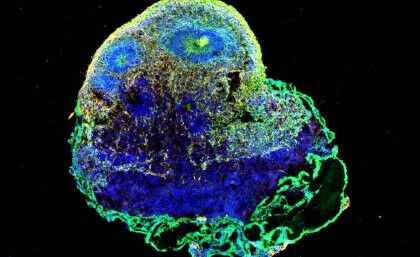博文
让因COVID-19老化的大脑时光倒转
||
让因COVID-19老化的大脑时光倒转
诸平
A brain organoid as seen under a microscope. Image: Dr Hannah Leeson, AIBN.
据澳大利亚昆士兰大学(University of Queensland简称UQ, St Lucia, Queensland, Australia)2023年11月22日提供的消息,澳大利亚昆士兰大学的研究人员参与的,由来自澳大利亚(Australia)、英国(UK)、美国(US)、智利(Chile)、德国(Germany)以及俄罗斯(Russia)的研究人员组成的研究团队,找到了一种方法来逆转由COVID-19引发的导致大脑过早衰老的细胞过程。上述图片是显微镜下看到的大脑类器官。相关研究结果于2023年11月13日已经在《自然衰老》(Nature Aging)杂志网站发表——Julio Aguado, Alberto A. Amarilla, Atefeh Taherian Fard, Eduardo A. Albornoz, Alexander Tyshkovskiy, Marius Schwabenland, Harman K. Chaggar, Naphak Modhiran, Cecilia Gómez-Inclán, Ibrahim Javed, Alireza A. Baradar, Benjamin Liang, Lianli Peng, Malindrie Dharmaratne, Giovanni Pietrogrande, Pranesh Padmanabhan, Morgan E. Freney, Rhys Parry, Julian D. J. Sng, Ariel Isaacs, Alexander A. Khromykh, Guillermo Valenzuela Nieto, Alejandro Rojas-Fernandez, Thomas P. Davis, Marco Prinz, Bertram Bengsch, Vadim N. Gladyshev, Trent M. Woodruff, Jessica C. Mar, Daniel Watterson, Ernst J. Wolvetang. Senolytic therapy alleviates physiological human brain aging and COVID-19 neuropathology. Nature Aging, 2023. DOI: 10.1038/s43587-023-00519-6. Published: 13 November 2023. https://www.nature.com/articles/s43587-023-00519-6
参与此项研究除了来自澳大利亚昆士兰大学的研究人员之外,还有来自美国哈佛医学院(Harvard Medical School, Boston, MA, USA)、美国麻省理工学院和哈佛大学布罗德研究所(Broad Institute of MIT and Harvard, Cambridge, MA, USA);德国弗莱堡大学(University of Freiburg, Freiburg, Germany)、德国弗莱堡大学医学中心(University Medical Center Freiburg, Freiburg, Germany);澳大利亚南澳大利亚大学(The University of South Australia, Adelaide, South Australia, Australia)、澳大利亚昆士兰全球病毒网络卓越中心(Global Virus Network Centre of Excellence, Brisbane, Queensland, Australia);智利南方大学(Universidad Austral de Chile, Valdivia, Chile)、智利瓦尔迪维亚铂金生物技术公司(Berking Biotechnology, Valdivia, Chile);俄罗斯莫斯科国立大学(Moscow State University, Moscow, Russia)、英国牛津大学(University of Oxford, Oxford, UK)的研究人员。
胡里奥·阿瓜多博士(Dr Julio Aguado)和来自昆士兰大学澳大利亚生物工程和纳米技术研究所 (UQ’s Australian Institute for Bioengineering and Nanotechnology简称AIBN) 的团队使用在实验室中用人类干细胞培养的合成脑类器官模型来研究不同 SARS-COV-2 变体对脑组织的影响。
胡里奥·阿瓜多博士说:“我们发现,COVID-19会加速‘僵尸’细胞或衰老细胞的出现,这些细胞会随着年龄的增长而在大脑中自然积累。众所周知,衰老细胞会导致组织炎症和退化,使患者面临脑雾和记忆丧失等认知障碍。”
胡里奥·阿瓜多博士表示,确认COVID-19是这种过早衰老的催化剂,促使人们尝试重置大脑生物钟。“我们使用大脑类器官来筛选一系列治疗方法,寻找任何能够去除这些衰老细胞的方法,”他说。
研究人员发现了四种可以选择性消除由COVID-19引起的细胞的药物:navitoclax、ABT-737、非瑟汀(fisetin)和达沙替尼(dasatinib)加槲皮素(quercetin)的混合物 (cocktail of dasatinib plus quercetin简称D+Q)。
胡里奥·阿瓜多博士说,这些药物可以使大脑恢复活力,并降低类器官以及感染COVID-19 的小鼠模型出现神经退行性症状的可能性。
他说:“需要更多的研究来充分了解其中的机制,但这项研究标志着我们在了解病毒感染、衰老和神经健康之间的复杂关系方面向前迈出了重要一步。从长远来看,我们预计这些药物将被广泛使用来治疗由COVID-19等病毒感染引起的持续性急性感染后综合症。”
AIBN类器官专家恩斯特·沃尔弗坦格教授(Professor Ernst Wolvetang)表示,人类干细胞衍生的大脑类器官使研究人员能够在人类受试者身上进行在伦理上和实践上都困难的实验。“我们的研究完美地展示了人脑模型如何加速治疗方法的临床前筛选,同时也走向无动物测试,从而具有潜在的全球影响。同样的药物筛选方法也可以帮助阿尔茨海默病(Alzheimer's disease)和一系列以衰老为驱动因素的神经退行性疾病(neurodegenerative diseases)的研究。”
该研究得到了德国研究基金会(Deutsche Forschungsgemeinschaft no. 413517907)、NHMRC创意资金(NHMRC Ideas grant no. 2012883; no. 2009957; no. 2001408)、澳大利亚传染病研究中心(COVID-19 seed grant from the Australian Infectious Diseases Research Centre)、ANID-FONDECYT (no. 1200427)、Posdoctorado Fondecyt (no. 3220635)、ARC发现项目(ARC Discovery Project no. DP210103401)、IBSA科学研究基金会(IBSA Foundation for Scientific Research)、热罗姆·勒琼基金会(Jérôme Lejeune Foundation)—昆士兰大学早期职业研究员资助(University of Queensland Early Career Researcher Grant application no. UQECR2058457)以及澳大利亚布里斯班儿童医院基金会(Brisbane Children’s Hospital Foundation grant no. Project-50308)的资助。
上述介绍,仅供参考。欲了解更多信息,敬请注意浏览原文或者相关报道。
Aging is a major risk factor for neurodegenerative diseases, and coronavirus disease 2019 (COVID-19) is linked to severe neurological manifestations. Senescent cells contribute to brain aging, but the impact of virus-induced senescence on neuropathologies is unknown. Here we show that senescent cells accumulate in aged human brain organoids and that senolytics reduce age-related inflammation and rejuvenate transcriptomic aging clocks. In postmortem brains of patients with severe COVID-19 we observed increased senescent cell accumulation compared with age-matched controls. Exposure of human brain organoids to severe acute respiratory syndrome coronavirus 2 (SARS-CoV-2) induced cellular senescence, and transcriptomic analysis revealed a unique SARS-CoV-2 inflammatory signature. Senolytic treatment of infected brain organoids blocked viral replication and prevented senescence in distinct neuronal populations. In human-ACE2-overexpressing mice, senolytics improved COVID-19 clinical outcomes, promoted dopaminergic neuron survival and alleviated viral and proinflammatory gene expression. Collectively our results demonstrate an important role for cellular senescence in driving brain aging and SARS-CoV-2-induced neuropathology, and a therapeutic benefit of senolytic treatments.
https://wap.sciencenet.cn/blog-212210-1410727.html
上一篇:揭示儿童罕见神经系统疾病的分子原因
下一篇:UCLA化学家使用氧气、铜“剪刀”使更便宜的药物治疗成为可能
